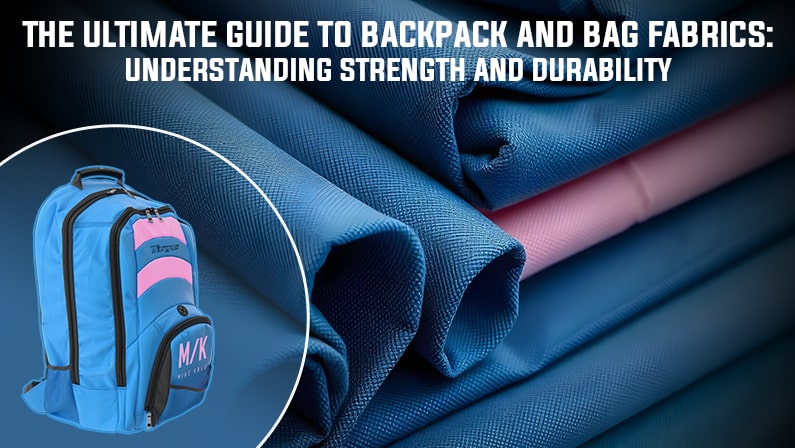
The Ultimate Guide to Backpack Materials
How to Choose the Right Backpack Fabric for Your Needs!
When it comes to choosing the perfect backpack or bag, backpack material plays a much bigger role than most people realize. The fabric isn't just about looks—it determines whether your bag will survive a rainy day, hold up during a rugged hike, or withstand years of daily use! Whether you're looking for a lightweight daypack or a heavy-duty outdoor backpack, understanding the various backpack materials used in bag construction will help you make an informed decision. Each backpack fabric offers unique properties, from strength and water resistance to abrasion protection and style.
In this guide, we'll explore what materials backpacks are made of, specialized fabrics for high-stress environments, and key fabric properties that determine their durability and longevity!
Backpack Materials: an Overview
Fabrics used in backpacks and bags serve different purposes depending on their application. Some backpack materials are chosen for lightweight properties, while others prioritize strength or water resistance. The right backpack material selection depends largely on how you intend to use the bag—whether for daily commuting, outdoor adventures, or heavy travel.
Natural Fabrics vs. Synthetic Fabrics
Natural fabrics like cotton canvas tend to have a rugged, classic look but are often heavier and less water-resistant. Synthetic fabrics, like nylon and polyester, dominate the modern bag market due to their light weight, strength, and ease of waterproofing. Synthetic materials can be treated with coatings, such as polyurethane coating, or weaves to enhance durability and functionality, making them the go-to choice for performance-focused outdoor backpacks.
Common Backpack and Bag Fabrics
Backpacks and bags are made from many different fabrics, each offering unique benefits in strength, weight, and durability. Let's examine some of the most popular backpack materials and their characteristics.
Nylon
Nylon backpack fabric, a synthetic material, is a top choice because of its strength and lightweight properties. It's highly durable and can be treated for water resistance, making it perfect for outdoor backpacks that need to handle tough conditions while staying light.
Polyester
Another synthetic fabric, polyester, is affordable and versatile. Although slightly less durable than nylon, it offers excellent UV resistance, so colors and prints won't fade easily. This makes polyester backpacks a great option for casual bags like school or promotional backpacks.
Canvas
Cotton canvas is a natural fabric, usually made from cotton, known for its heavy-duty feel and durability. While it's heavier than synthetic materials, it has excellent abrasion resistance and a rugged look. Waxed cotton canvas bags offer added water resistance, making them popular for canvas backpacks, outdoor, and vintage-style bags.
Leather
Leather is a natural material that adds a luxurious, premium feel to any bag. Known for durability and a long lifespan, leather develops a beautiful patina with time. It's frequently used in high-end or laptop bags where style and toughness are key.
High-Strength and Durable Fabrics
For backpacks and bags that require extra durability, certain fabrics are designed to withstand heavy use and extreme conditions. These durable materials are built to last and offer superior performance.
Ripstop Nylon
This synthetic fabric features a grid of reinforced threads to prevent tears from spreading, making it incredibly durable and lightweight. Ripstop nylon is a favorite for hiking backpacks and outdoor gear, where strength and weight savings are important.
Cordura
Cordura is a synthetic fabric known for its exceptional toughness. It resists abrasions, scuffs, and tears, making it a popular choice for heavy-duty backpacks like external frame backpacks, tactical bags, and gear designed to last through tough conditions.
Kevlar
Kevlar, another synthetic fabric, is famous for its extreme strength and cut resistance. Though heavier and more expensive, Kevlar is the best backpack material for bags that require maximum protection, such as tactical or industrial bags.
Dyneema (Cuben Fiber)
Dyneema is an ultra-strong yet lightweight synthetic fabric ideal for high-performance outdoor gear. Despite being featherlight, it offers exceptional tensile strength and water resistance, making it great for climbers and adventurers who need tear-resistant, durable, and lightweight gear.
Measuring Fabric Durability
Understanding how fabric durability is measured can help you choose the right backpack material! Several testing methods and fabric properties indicate how well the material will perform. Below are some of the key factors that determine fabric durability:
Denier Rating
Denier is a measurement of the thickness of fibers in the fabric. A higher denier rating means thicker and stronger fibers, which generally results in greater durability. For example, 1000D nylon is thicker and more resistant to wear than 400D nylon. High-denier fabrics are ideal for outdoor and heavy-use backpacks, while lower-denier fabrics provide a more lightweight, flexible option.
Tear Resistance
Tear resistance measures how well a fabric can withstand being pulled apart. Ripstop fabrics, like ripstop nylon, are designed with reinforced threads to prevent small tears from growing. Fabrics with high tear resistance are essential for bags that will get a lot of rough handling or outdoor use.
Abrasion Resistance
This property refers to how well the fabric can withstand friction and rubbing. Fabrics like Cordura and Kevlar have high abrasion resistance, so they are often used in frame backpacks that receive constant wear in tough conditions, such as tactical or hiking backpacks.
Water Resistance
Some fabrics naturally repel water, while others require special coatings. Nylon and polyester can be treated with water-resistant coatings, while materials like Dyneema are inherently waterproof. Water resistance is crucial for outdoor backpacks used in wet or unpredictable environments to protect your gear from getting soaked.
Fabric Maintenance Tips for Longevity
Proper care and maintenance are essential to help your backpack last as long as possible. Different backpack materials require different care techniques to maintain their strength, appearance, and functionality over time.
Regular Cleaning
For synthetic fabrics like nylon and polyester, regularly wiping down your bag with a damp cloth can remove dirt and debris that may weaken the fabric over time. For deeper cleans, most synthetic fabrics can be hand-washed using mild soap and warm water. Avoid using harsh detergents that may strip water-resistant coatings. Natural fabrics like cotton canvas and leather require more gentle cleaning methods; canvas can often be spot-cleaned, while leather should be treated with specialized leather cleaners and conditioners.
Avoid Prolonged Sun Exposure
UV rays can break down backpack fabrics and cause colors to fade, especially with synthetic materials like polyester. Store your backpack in a shaded area when not in use, and avoid leaving it in direct sunlight for long periods.
Waterproofing Maintenance
If your backpack has a water-resistant coating, it may wear off over time. To maintain water resistance, consider reapplying a water-repellent spray, especially after extensive use in wet conditions. For waxed fabric canvas bags, you can periodically reapply wax to restore water resistance and keep the fabric in top condition.
Proper Storage
Store your backpack in a cool, dry place to avoid mold and mildew, which can damage both natural and synthetic fabrics. Leather bags should be stored in breathable dust bags to prevent moisture buildup. When not in use, avoid overstuffing your bag, as this can cause unnecessary strain on seams and fabric fibers.
Future Innovations in Backpack Fabrics
The world of backpacks is constantly evolving, with new fabrics and technologies being developed to meet modern demands. Here are some key innovations shaping the future of bag fabrics:
-
Sustainable and Eco-Friendly Fabrics: Many brands are adopting eco-friendly materials like recycled polyester made from plastic bottles, offering the durability of traditional polyester with reduced environmental impact. Organic cotton and biodegradable fabrics are also popular with environmentally conscious consumers.
-
Smart Fabrics: Technological advances are introducing smart fabrics with sensors that can monitor temperature, detect environmental changes, or even charge devices via solar power!
-
Ultra-Lightweight Materials: As demand for lightweight gear increases, new fabrics like Dyneema (Cuben Fiber) are gaining traction for their incredible strength-to-weight ratio. These materials provide durability and weather resistance while keeping bags light and portable.
-
Advanced Waterproofing Technologies: Innovations in waterproofing, such as nano-coatings, offer superior moisture protection without compromising breathability. These technologies allow fully waterproof bags that remain flexible and lightweight.
-
See-Through Backpacks: Clear PVC or TPU fabrics are common for security-conscious environments like stadiums or schools. While these see-through materials may not be as durable as traditional fabrics, they offer convenience and quick visual access to the bag's contents.
Your backpack's fabric is its true backbone. It's the difference between a bag that falls apart and one that keeps going, adventure after adventure. And as materials get smarter, lighter, and more sustainable, the options are endless!
Whether trekking through the wilderness, commuting in unpredictable weather, or just looking for something stylish and durable, understanding fabric choices is key to finding the perfect bag. If you invest in fabrics that suit your lifestyle, your bag will have your back for years!
Frequently Asked Questions
Q: What is the strongest fabric used in backpacks?
A: Kevlar and Dyneema are among the strongest materials used in backpacks. Their high tensile strength and puncture resistance make them ideal for extreme conditions.
Q: Which fabric is the most waterproof for backpacks?
Dyneema (Cuben Fiber) and TPU-coated nylon are highly waterproof, making them great choices for keeping gear dry in wet conditions. It's important to have a waterproof zipper as well!
Q: Does the color of the fabric affect its durability?
A: Color doesn't impact durability, but darker colors may hide dirt better, and lighter colors may show wear and tear more visibly over time.
Q: What is the difference between ripstop nylon and regular nylon?
A: Ripstop nylon has a reinforced grid pattern that prevents small tears from spreading, making it much more durable than regular nylon in rugged conditions.








